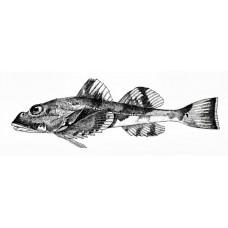Latin name
Myoxocephalus polyacanthocephalus
Identification
The body of the great sculpin is rather thick and naked, without bony plates or spines. Its head is high and not flattened, and it is covered with smooth skin. There are bony ridges on its head, as well as powerful spines on its gill cover. The broad, concave forehead is noticeable. The interorbital space is wide and concave. They have cell-free bones. The upper preoperculum spike is the longest, and the second spike is about one-third the length of the first. More often, there are three spines, but there can be four. The canals of the seismosensory system are strongly branched with numerous small pores.
Features of fish fins
Great sculpins have dorsal fins supported by eight to ten spines and thirteen to sixteen soft rays. Their anal fins have eleven to thirteen soft rays. The third, fourth, and fifth rays of the first dorsal fin are the largest, and the fin's upper profile is convex. Large individuals often have a free space between their dorsal fins.
Fish colouring
The great sculpin has a brownish body with clearly defined, broad, transverse stripes. A light band runs along the posterior edge of the caudal fin.
Distribution
This species of fish is found in the northern Pacific Ocean, from the Bering Sea and the Aleutian Islands to Puget Sound in Washington State, and from Hokkaido to the Kamchatka Peninsula.
Habitat
This is a marine benthic species that prefers temperate climates. It inhabits coastal and shelf waters up to a depth of 320 meters.
Size
It is the largest species in the Myoxocephalus genus and the second most prevalent in the Bering Sea. It can grow to 80 cm in length and weigh up to 9 kg. This species is characterized by pronounced sexual dimorphism in size. Males are nearly two to three times smaller than females.
Behavior
They are relatively sedentary fish that migrate seasonally throughout the year. In the summer, they travel to the relatively warm coastal zones to feed. In the winter, they travel to the depths to hibernate and spawn.
Food and feeding habits
Predatory Fish: They mainly eat fish and decapods.
Reproduction
Females produce 400,000 to 450,000 eggs. They lay the eggs in clusters on plants and in mussels in shallow water. The males guard the eggs until they hatch.
Fishing
This species is not commercially important.
Relationship with a person
Harmless.
| Classification | |
| Phylum | Chordata |
| Class | Actinopterygii |
| Squad | Perciformes |
| Family | Psychrolutidae |
| Genus | Myoxocephalus |
| Species | M. polyacanthocephalus |
| Features | |
| Conservation status | Not Evaluated |
| Habitat | Bottom |
| Life span, years | No information |
| Maximum body weight, kg | 9 |
| Maximum length, cm | 80 |
| Sailing speed, m/s | No information |
| Threat to people | Edible |
| Way of eating | Predator |
Great sculpin
Tags: great sculpin

